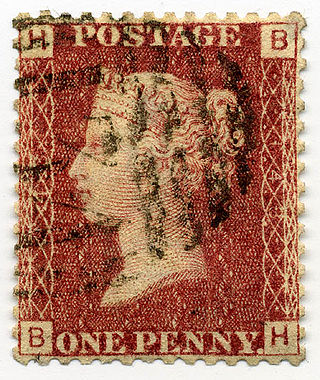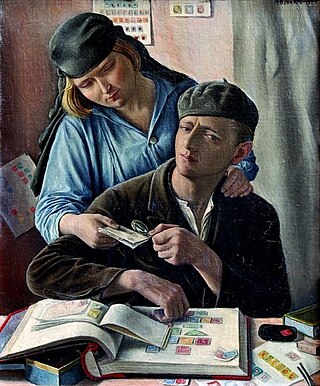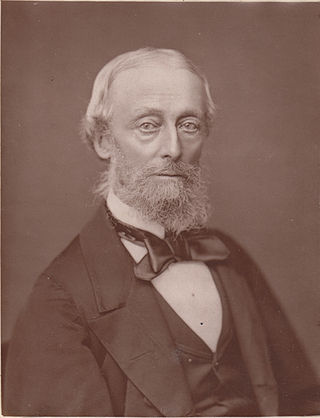
Philately is the study of postage stamps and postal history. It also refers to the collection and appreciation of stamps and other philatelic products. While closely associated with stamp collecting and the study of postage, it is possible to be a philatelist without owning any stamps. For instance, the stamps being studied may be very rare or reside only in museums.

Stamp collecting is the collecting of postage stamps and related objects. It is an area of philately, which is the study of stamps. It has been one of the world's most popular hobbies since the late nineteenth century with the rapid growth of the postal service, as a stream of new stamps was produced by countries that sought to advertise their distinctiveness through their stamps.

Philatelic literature is written material relating to philately, primarily information about postage stamps and postal history.

A stamp catalog is a catalog of postage stamp types with descriptions and prices.

L.N. and M. Williams were a philatelic writing partnership made up of brothers Leon Norman Williams and Maurice Williams (1905–1976).

Edward Benjamin Evans, a British army officer also known as "Major Evans", was a distinguished philatelist, stamp collector, and philatelic journalist. His philatelic specialization included Mauritius, the Confederate States of America, the Mulready envelopes, and the Indian feudatory states.

The Chalon Head is the name of a number of postage stamp series whose illustration was inspired by a portrait of Queen Victoria by Alfred Edward Chalon (1780–1860).

Sir Edward Denny Bacon was a British philatelist who helped with the enlargement and mounting of collections possessed by rich collectors of his time and became the curator of the Royal Philatelic Collection between 1913 and 1938.

Alfred Potiquet was a French official who was responsible for the first stamp catalogue in the world. The 1861 first edition is held by the Royal Philatelic Society London.

Walter Morley (1863–1936) was a pioneering English philatelist, stamp dealer and philatelic author.

Frederick John Melville was a British philatelist, prolific philatelic author and founder of The Junior Philatelic Society. He was also a founder in 1907 of the Philatelic Literature Society. Melville is a member of the American Philatelic Society's Hall of Fame and was a signatory to The Roll of Distinguished Philatelists in 1921.

Frederick William Booty was an English artist who was also the author of the first postage stamp catalogue in English, and the first illustrated stamp catalogue anywhere.

The Crawford Library is a library of early books about philately formed between 1898 and 1913 by James Lindsay, 26th Earl of Crawford. By the time of his death in 1913, Crawford was thought to have amassed the greatest philatelic library of his time. Today, the library is part of the British Library Philatelic Collections.

Charles William Viner A.M., Ph.D., was a British philatelist who was a founding member of the Philatelic Society, London, later to become the Royal Philatelic Society London, and who was present at the initial meeting of the society on 10 April 1869, and serving as its Secretary from 1871 to 1874. His obituary in The London Philatelist referred to him as the "Father of Philately" and elsewhere he was described as the vieille garde of philately having been actively collecting and writing about stamps since 1860. In 1921 he was entered on the Roll of Distinguished Philatelists as one of the founding Fathers of philately.

The Reverend Francis John Stainforth was an early British philatelist, conchologist, and collector of books by women writers. He was the Perpetual curate of All Hallows Staining church in London, where Mount Brown compiled large parts of his catalogue. The church was believed to be the one mentioned by Charles Dickens in Dombey & Son.
Edward A. Oppen was the creator of one of the first stamp catalogues in English as well as the author of a number of foreign language textbooks. In a stamp collecting journal, he was described as a "...classical teacher".

Edward Loines Pemberton was a pioneering philatelist and stamp dealer who was a leading advocate of the scientific school of philately and a founding member of The Philatelic Society, London, now The Royal Philatelic Society London. Pemberton was entered on the Roll of Distinguished Philatelists in 1921 as one of the fathers of philately. He was born in New York City but educated in Britain by relatives when his parents died shortly after his birth. His son, Percival Loines Pemberton (1875-1949) was also an eminent philatelist.

William Amos Scarborough Westoby M.A. (1815–1899) was an English philatelist who was one of the "Fathers of Philately" entered on the Roll of Distinguished Philatelists in 1921. His obituary in The London Philatelist stated that he had "...fairly earned the title of the Grand Seigneur of Philately." By profession, Westoby was a barrister of Lincoln's Inn.
Douglas Brawn Armstrong was a British philatelist who was added to the Roll of Distinguished Philatelists in 1959.
John Barefoot is a British philatelist, stamp dealer, and publisher, best known for his catalogues of revenue stamps which are known collectively as the "Barefoot catalogue".


















